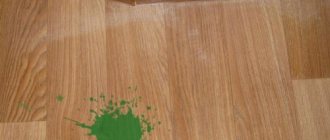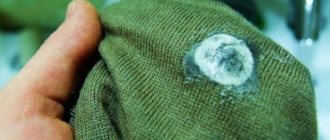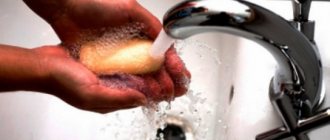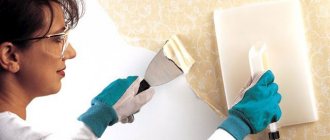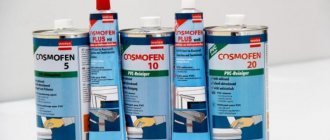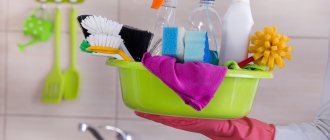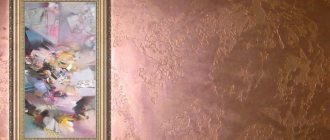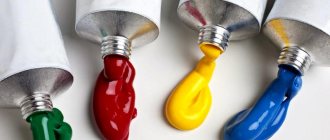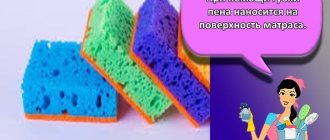Getting rid of this stain is not as easy as it might seem at first glance, and it is simply impossible to remove the stain with your fingernails or a knife while maintaining the appearance of your item. But there are many effective ways to solve the problem without leaving home. In this article we will answer a common question: how to wash PVA glue from clothes or remove, remove, remove sticky stains from fabric?
All known ways to remove PVA glue from clothes
PVA glue is undoubtedly a necessary thing in the household, but it must be handled with extreme care. In the process of work, people, without noticing it, stain their clothes by touching the adhesive mass, which, after drying, turns into noticeable stains.
People are often interested in how to remove PVA glue from fabric, without even thinking about the fact that it can sometimes be easy. In most cases, when a person discovers stains on his clothes, he goes to a dry cleaner, where, for a lot of money, they remove the stain using the same methods that he can use at home.
In fact, there are quite a lot of options on how to remove PVA glue from clothes. For this, improvised means are used - food ingredients or bit chemistry - they are present in every home. Below are several time-tested solutions to the problem. Each of them is effective and safe, if, of course, you act strictly according to the instructions.
How to remove by freezing
Since the target is a stain from a substance that contains water, it will be possible to remove PVA glue stains on clothes using low temperatures.
The essence of the method is that the composition with polyvinyl acetate freezes and becomes brittle, after which it practically leaves the fabric on its own.
To solve the problem, you need to take the contaminated item of clothing and place it in the freezer. After a couple of hours, you will need to use a hammer to break up the dried traces of sticky mass. Next, the remaining product should be scraped off with a knife and shaken off. The last step, in order to completely remove PVA glue stains from clothes, is to wash them in soapy water.
How to remove with vinegar
Using vinegar is an equally effective method. It is also a winning answer to the question: how to remove PVA glue from clothes at home? To do this, you will need a 9% solution and a regular cotton swab. After wiping the contaminated area with vinegar, traces of the adhesive must be eliminated - they will be removed as a solid film, without residue. And immediately after this, the item of clothing should be washed as usual.
How to remove with alcohol
Oddly enough, medical alcohol helps remove PVA glue stains on clothes. It is suitable for removing dirt from linen or cotton products. This method works almost exactly like the previous one - you need to moisten a cotton pad with the composition and apply it to the stain for a couple of minutes. After the specified time, the tampon should be removed (the glue should remain on it). So, you can clean clothes from PVA glue in just less than 5 minutes.
Using citric acid
If a woolen sweater or any other warm item is contaminated, you can remove PVA glue from the fabric using citric acid. Here you need to prepare 100 ml of ordinary water and 20 g of lemon juice. These components should be combined and mixed thoroughly.
How to clean PVA glue from clothes at home with a citric acid solution:
- Take the solution into a teaspoon.
- Pour evenly onto the stain (you can go a little beyond it, but so that the trace of glue itself is completely covered).
- Wait about half an hour.
- Wash the item in the washing machine on high speed.
How to remove fresh stains?
It is easiest to deal with a fresh stain when a white drop has not yet hardened on the surface of the fabric. In this case, you will have to act quite quickly. The method of getting rid of contamination should take into account the composition of the glue.
The main components of PVA are:
- water emulsion of polyvinyl acetate;
- plasticizing additives.
Washing procedure:
- Remove the bulk of the glue from the material with a napkin or rag. You need to work with blotting movements so as not to smear the stain even more.
- If possible, remove any remaining product with a sharp tool using scraping movements, moving from the edges to the center. It is better not to experiment with such processing with delicate materials.
- Hold the stained area of fabric under running water, directing it so that the stain is washed.
- In a separate container, dilute the detergent (gel, grated laundry soap or powder) in warm water.
- Dip the item into the washing solution.
- Leave for about half an hour.
- Rub the affected area.
- Wash the product in any convenient way.
Intense exposure should be avoided so as not to damage the tissue itself.
Thermal cleaning methods (iron, hair dryer, etc.)
Having learned about the freezing method, it is worth considering the opposite option, how to remove PVA glue from clothes at home. This involves exposing the sticky trace to heat. In this case, the glue will become softer and more elastic, and therefore it will be easier to remove it without leaving small particles.
You can remove PVA glue from clothes at home using a hairdryer, iron or special cooking devices. We will consider the most common methods below.
Using steam
Many people, asking the question of how to remove PVA glue from clothes, do not believe that steam really helps with this. In fact, this method is very reliable and effective. Here you will need to use an iron with a steam supply, a double boiler, a kettle or any other tool that can produce a large jet of steam.
How to remove PVA glue stains from clothes:
- Take the item and turn it with the spot facing out.
- Direct a jet of steam onto the contaminated area and hold for about 5 minutes.
- Wipe the affected area with a slightly damp sponge.
If the glue does not come off immediately, you need to keep it over steam for some time. This way it will soften better and, quite possibly, fall off on its own.
This method is ideal for people looking for an answer to the question: how to remove PVA glue from clothes, leaving them dry? After all, after the dirt disappears, the item does not need to be washed, and the mark left by a damp sponge will dry under the same stream of steam after just 1-2 minutes.
How to clean with a hair dryer
Experienced craftsmen who have been working with various sticky compounds for a long time often have a question: how to remove PVA glue from trousers in a short time? The answer is simple - a hairdryer will help.
Moreover, both a regular device for drying hair and a hair dryer are suitable here.
It works in the same way as steam - a stream of warm air needs to be directed at the stain, and after a while the contamination must be removed with a damp cloth or metal scraper.
This method of getting rid of the problem of how to remove PVA glue from fabric is considered the fastest. This is explained by the ability to regulate the strength of the air flow from the hair dryer.
Recommendations
The following tips will help you deal with the problem of traces of PVA glue on clothes:
- Solvents that are aggressive in their effects can damage fabric fibers, so their use should be limited and only used when other methods have failed.
- When removing stains, especially those involving chemicals, it is best to wear rubber gloves.
- The longer the stain remains on the material, the more difficult it will be to remove.
- The technology for cleaning an item should take into account the type of fabric, its color, the presence of decor, etc.
Useful information on how to remove traces of glue from clothes is in this section.
How to wash clothes from PVA glue using household chemicals (washing chemicals, solvents, etc.)
The next answer to the question about how to remove PVA glue from clothes is household chemicals. Any detergents and chemical solvents are suitable here. The principle of working with these compounds is simple:
- Apply the active product to the stain.
- Leave for 30 minutes.
- Place the item in the washing machine on normal cycle.
Now it’s no secret how to wash off PVA glue. This can be done right in the bathroom where the washing machine is located. After washing as usual, the item must be inspected immediately - there should be no marks on it.
If you don’t know how to remove PVA glue from clothes at home, you should choose this method. It will allow you to end up with a clean and refreshed item, from which other contaminants will be removed after washing.
Use of other chemicals
In addition to household chemicals, there are several other products that can help solve the problem of how to remove PVA glue from clothes. They are, one might say, somewhat specific, but they work flawlessly, so it’s worth a try in any case. Listed below are methods that will definitely help in cases where other options for removing PVA glue from clothes have not given a positive result.
Various oils
Speaking of how to remove stains from PVA glue on clothes, it is recommended to turn to baby or vegetable oil.
Since certain types of polyvinyl acetate-based products are resistant to acetone and alcohol, this method is perfect for them.
Procedure for removing PVA glue from clothes:
- Apply oil to the stain.
- Rub the product into the fabric.
- Wait for the chemical processes to occur (about half an hour).
The considered method of how to clean clothes from PVA glue is effective for the reason that some sticky masses are created on the basis of oil, which is why they are removed using similar compositions. After carrying out all of the above steps, remove the residue with ordinary soapy water.
Baking soda
Soda paste is an excellent solution to the problem of how to remove PVA glue from clothes. It is prepared from ordinary baking soda and water, taken in equal quantities. The finished product must be applied to the stain and left for 25-35 minutes. Next you will need to remove the residue with warm water.
This method of washing PVA glue from clothes is safe. It does not harm the fabric in any way and does not leave white marks behind.
Solvents (acetone, white, etc.)
An effective method for cleaning PVA glue for construction purposes comes down to the use of solvents. They act as the so-called “heavy artillery” and are used, as a rule, in the most extreme cases. Effective means are: turpentine, white spirit, acetone, solvent for paints or varnishes, etc.
You can remove a PVA glue stain from clothing as follows:
- Test the solvent by applying a couple of drops to the underside of the fabric and waiting about 10 minutes - if the color of the surface does not change, the product can be used.
- Soak a cotton swab in the solvent and apply it to the stain for 15 minutes.
- Scrape off any dirt with the back of the knife.
- Remove the cotton wool and rub the treated area of clothing with laundry soap or washing powder.
- Machine wash the item of clothing.
Refined gasoline
If you need to answer how to wash PVA glue, you should turn to gasoline. Available in construction and hardware stores, used to remove oil stains. This is not the kind of gasoline that is sold at gas stations, which leaves traces of exposure after drying.
It acts in the same way as a solvent - it is applied to a trace of sticky mass, after a while the fabric is treated with soap and washed. But, unlike other compounds, gasoline gives off a more specific odor, which does not always wash off.
Therefore, knowing how to wash PVA glue from clothes, it is worth learning the rules for handling the item after this procedure - you need to hang it outside and leave it until the aroma disappears. It is not recommended to use any perfumes or deodorants.
Anticlean
Experienced craftsmen know how to clean PVA glue from clothes and hands, so before starting to work with this product, they purchase a special composition called anti-glue. It can be found at a regular hardware store. Professionals recommend stocking up on this product for a long time, so that after repair and construction work the question of how to remove PVA glue from clothes does not suddenly arise.
Anti-glue is applied to a sponge, which needs to be thoroughly rubbed onto the stain. After some time of friction, the marks will begin to disappear. This should lead to complete elimination of contamination. If there are still residues, you can get rid of them by washing the item in the machine or by hand.
Top 3 special tools
In some situations, homemade recipes may not help. Then special drugs will come to the rescue.
Grass Antigraffiti
This product, Grass Antigraffiti, is an effective product for removing traces of glue, chewing gum, tape, etc.
It contains:
- surfactant;
- organic solvents and other components.
The cost of a 0.6 liter bottle. with a sprayer - about 300 rubles. The drug is also available in 5 kg canisters.
Advantages:
- efficiency;
- economical consumption;
- affordable price for a fairly large volume.
Flaws:
- strong unpleasant odor;
- may damage the material;
- It does not cope with all traces of glue on fabric.
Duty Universal
The product is a professional remover of glue and adhesive base of stickers, tape, etc. The product has an enhanced effect and is produced in Russia.
Compound:
- Non-ionic surfactants – 5%;
- isobutane;
- D-limonene;
- organic compounds.
Advantages:
- efficiency;
- ease of use;
- may damage the surface of the material;
- quick results;
- no effort required;
- copes well with old marks;
- good volume.
Minuses:
- pronounced strong odor;
- sometimes re-processing is required.
Mellerud
- Soak a napkin in Mellerud.
- Moisten the stain area.
- After the reaction has passed, the remaining glue can be cleaned off.
- Rinse the surface of the material under water and wash as usual.
The product has good reviews. Its disadvantage is the high cost for a small volume and the need in some cases to repeat the processing.
Removing office PVA
Caring parents, whose children do needlework but are often inattentive, are also interested in how to remove PVA glue.
Since the stationery product is made on the basis of silicate components, it can be easily removed with cold water with the addition of soda and soap.
They need to be taken in a ratio of 3:1:1 and rubbed into the area of contamination. This solution is perfect as an effective way to remove PVA glue from clothes. Afterwards, the item should be put in the washing machine on a low cycle.
How to clean dried PVA glue
A question no less interesting to people is how to wash PVA glue from clothes once it has already hardened. Here, unlike the previous method, water will not help at all. But it’s still possible to find the right solution - nail polish remover.
It needs to be applied to the dirt, and after 15 minutes, wash the item. This answer to the question of how to wash PVA glue is on the list of the simplest and fastest, because it will take less than half an hour to implement, not taking into account the subsequent drying of the item of clothing.
Removing PVA glue from furniture upholstery
There is a stain from PVA glue on the furniture, how can I remove it? This question is also gaining popularity, because when working with sticky mass, as a rule, they do not cover all surrounding objects with newspapers. It is best to remove dirt before it dries - here you can simply wipe it off with a damp cloth. If the glue has dried, you will need to spend a little more effort and time.
You can remove stains from furniture upholstery using solvents (acetone, gasoline, nail polish remover, paint thinner). The selected product must be applied to the glue mark, and after 30 minutes, rub this area with a soapy sponge. When the sticky mass disappears, you need to carefully remove the soap by treating the area with a clean, damp cloth.
Cleaning glass surfaces from PVA
First of all, you need to understand at least approximately how long it takes PVA glue to dry on glass. This period of time varies from 1 hour to a day (depending on the type of glue and environmental factors). Therefore, a person has at least 60 minutes to remove fresh drops of sticky mass with a simple sponge dipped in water.
If you are interested in how to wash PVA glue from glass, you need to consider ways to fix the problem with the fabric. Some of them are great for glass surfaces.
For example, purified gasoline, ammonia, and an iron with a steam function are suitable here.
All these methods were described above, and they are also perfect for the problem of how to wash PVA glue from glass. These methods are aimed at softening the stain, and after using them, the glass surface does not need to be treated with soapy water, because the stain can be wiped off with a simple sponge (even a dry one).
After the operation, it is recommended to polish the glass. This will improve its appearance and help identify and eliminate other existing problems.
How and with what to wipe the monitor
A computer or laptop monitor is a problematic and “delicate” place. Therefore, even with full knowledge of how to wash PVA glue from screen glass, you should remember to be careful.
A weak soap solution will help here: you need to apply it to a rag and treat the screen with upward movements (without pressing) until all traces of the adhesive mass are removed. This is the case if you don’t have a universal cleaner for plasma, LCD and TFT screens at hand.
How to wash it off a tree
Wooden products also require a special approach. Here the methods are more interesting and time-consuming, but quite effective and safe.
So, how to remove a stain from PVA glue:
- A mixture of laundry soap (shavings) and water. These components are taken in a 1:2 ratio, mixed thoroughly and applied to the glue trail. After 10 minutes, this mass must be removed with a sponge, and then rub it over the treated area to remove all residues.
- Iron. The first step is to apply clean paper to the tree and place a cotton cloth on top. Next, this area needs to be ironed several times. As a result, the stain will soften and move away from the surface on its own.
- Vegetable oil. It is recommended to apply it to the adhesive layer and leave for 3 hours. Afterwards, the sticky mass will simply lose its properties and dissolve on its own along with the oil.
So, we answered the question of how to remove PVA glue from wood. All three methods can be implemented at home.
Cleaning from plastic
When working with plastic, there is rarely a problem with how to clean PVA glue. This material is not exposed to water and does not adhere well. Therefore, a fresh layer of sticky composition can be removed from it with a damp cloth, and an already dried layer can be removed with a spatula, prying it by the edges and removing it like a regular film.
How to remove it at home?
If the PVA stain was not noticed immediately, you will have to use more serious methods to eliminate it. In the case where the trace of glue remains voluminous, you must first try to remove the bulk of the frozen substance.
If the fabric cannot withstand such treatment, then it is better to use soda:
- wet and squeeze out the sponge;
- dip a washcloth in soda;
- working from the edges of the stain towards the center, rub the area;
- stand for half an hour;
- wash the damaged area of the item first;
- wash the entire product.
It is recommended to take into account the brand of glue, since its construction varieties have greater durability and better adhesive ability compared to stationery ones.
Vinegar
Table vinegar will help to deal with old glue stains. This method can be helpful for cleaning thin fabrics, such as chiffon.
Application:
- Lay out the product horizontally.
- Soak a sponge in vinegar.
- Place a sponge on the stained area.
- Allow the time necessary for the reaction to occur, as a result of which the PVA film begins to wrinkle.
- Carefully remove the glue.
- Wash the product.
Alcohol
Before removing traces of glue, the item should be turned inside out. Operating procedure:
- place the item on a horizontal plane;
- Place a sheet of cardboard under the area to be treated - this will prevent the stain from moving to the other side;
- moisten a cotton sponge or swab in alcohol or vodka;
- Treat the stain with blotting movements, ensuring that the dried glue dissolves;
- wash as usual.
The use of alcohol is indicated for linen, cotton, and denim fabrics. Read about removing glue stains from jeans here.
Exposure to high temperatures helps remove the adhesive from the material. It is convenient to use a regular iron for this.
Work order:
- The item with the stain is placed on the ironing board.
- Place a piece of white cotton cloth over the stain.
- From the inside, fabric is also placed under the product.
- Iron it, trying to get the glue absorbed into the additional fabric.
- Wash using powder or gel.
Ammonia
Ammonia as a cleaner can be used either independently or in addition to another type of treatment, for example, steam.
Moisten the sponge with ammonia and achieve good hydration of the stain by applying it for a quarter of an hour. The remaining glue is removed, and the item is washed.
Using ammonia will help in cases where other means cannot be used - for example, when cleaning suede.
Freezing
The use of low temperatures is a fairly effective approach. You can use it if the soiled item is small and can fit in the freezer compartment of the refrigerator.
For this:
- The product stained with PVA is placed entirely in a plastic bag.
- The package is placed in the freezer.
- Leave for several hours - long enough for the glue to harden and become completely hard.
- They take out the thing.
- Lay out the product on a horizontal plane, soiled side up.
- Tap the frozen drop with a wooden hammer so that the glue begins to break off. Splinters should be removed from the fabric immediately.
- Finish the glue mark with a knife.
- If there are remains of PVA at the site of the former stain, they are removed with ammonia.
- Carry out normal washing with washing powder and a small amount of soda (1 tsp).
- Rinse the product.
Steam exposure can be effective. High temperatures can also disrupt the structure of the adhesive and contribute to its destruction.
Removing stains:
- bring a kettle of water to a boil;
- place the stained area of material under a stream of steam, ensuring that the glue begins to melt;
- carefully, using tweezers, collect the glue;
- wipe the remaining trace with ammonia diluted half and half with water;
- wash the product.
When using steam, be careful not to get burned.
